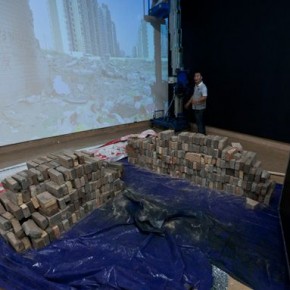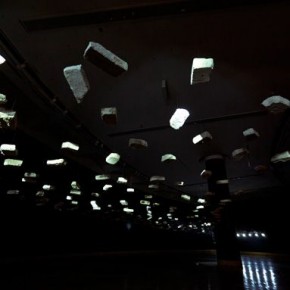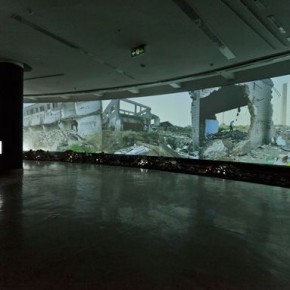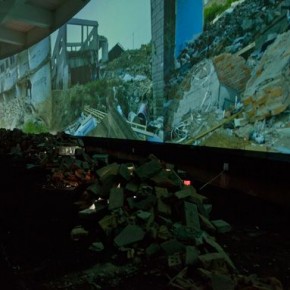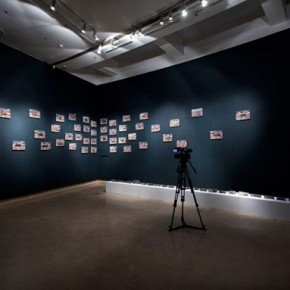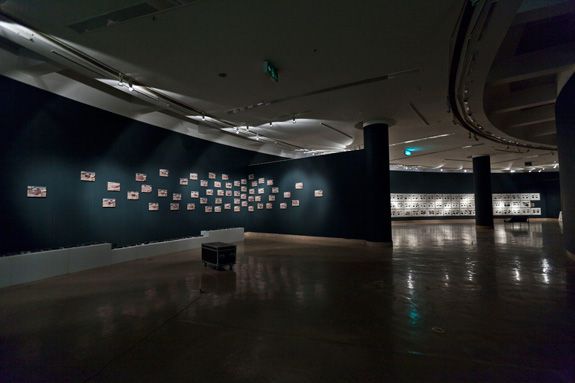
Hosted by CAFA and Shaanxi Province Art Museum, planned by Hang Chunxiao, “Ruins: Re-deconstruction of the Mode of Ink by Li Gang” is held at Shaanxi Province Art Museum, on July 10 through to July 20, 2013. It’s the second new experience since the solo exhibition in 2012, featuring a new form – video and installation, instead of easel ink painting, to express his understanding and attitude to experimental ink.
It’s obvious that Li Gang’s ink paintings fail to reflect a visual illusion of the style of ancient architecture. What is a “visual illusion?” When a tourist visits the ruins of ancient architecture, what he/she sees is not the ruins themselves, but a cultural imagination wrapped in a variety of discourse. Thus, the visual appearance is no longer the vision itself, but the cultural landscape of imagination. So does ink painting become an historical relic. It often becomes the object of nostalgic tour today – the stature of people in front of ink painting is usually controlled by a cultural imagination, making it become an imaginary thing like a tourist destination. However, when the ancient ruins depart from the historical background, all the imaginations related to the history are romantic “mirages”, rather than the reality of today. Just like the Summer Palace, except for the seemingly tragic historical landscape, it truly reflects the calmness while the artifacts return to nature. So does ink painting, prevailed on by the related terms of pen and ink, literati, etc., “cultural mirage” become romantic films for viewing, deleting its material quality as an artistic medium, finally becoming a stale repertoire. Li Gang, who had disseminated it was quickly alerted, trying to give up the generation mode of “visual illusion” in an abstract manner. With a decade of “nonsense” (a joke by Li Gang’s friend), his folding, rubbing, and transfers are considered an “abstract experience” the original of ink and wash – that’s the promotion of the two aspects including graphics and media, arousing people’s attention. It’s certain that his works get rid of ink imaginations through the usual experience, inspiring the self-expression of the ink and wash media with formalism. But since the birth of “abstract ink” in the 1980s, it has been saddled with responsibility – to prove the value of ink painting with the use of artistic logic across the world. If we treat the responsibility as a defaulted attitude, the “abstract ink” naturally has another imagination as being “against historical and cultural imagination” – the “visual illusion” of skyscrapers appearing after the ancient architecture. After abstract ink, experimental ink and performance ink were promoted, trying to get out of the shadow of a “visual illusion”.
Going into the ruins of modern architecture, Li Gang explores the logic of “getting out of it”. Folding, rubbing and transfer, etc were transformed into a specific program about “ruins”, in addition, the exhibition space is constructed using various media including real objects, videos, etc, deleting some defaulted definite meanings, to generate a “metaphor” in the symbiotic structure of ink and ruins: As with cultural ruins, ink painting prefers to find the obscured visual effectiveness in the process of getting rid of various “visual illusions”, activating the ideographic space of “ruins” in the reconstructing, to form romantic aesthetic nostalgia.
About the exhibition
Title: Ruins: Re-deconstruct the Mode of Ink by Li Gang
Curator: Hang ChunxiaoArtistic Directors: Wang Huangsheng, Luo Ning
Duration: July 10 – July 20, 2013
Opening: 15: 30 pm, July 10, 2013
Venue: Shaanxi Province Art Museum (Chang’an North Road No.14, Xi’an, Shaanxi Province)
Translated by Chen Peihua and edited by Sue/CAFA ART INFO








